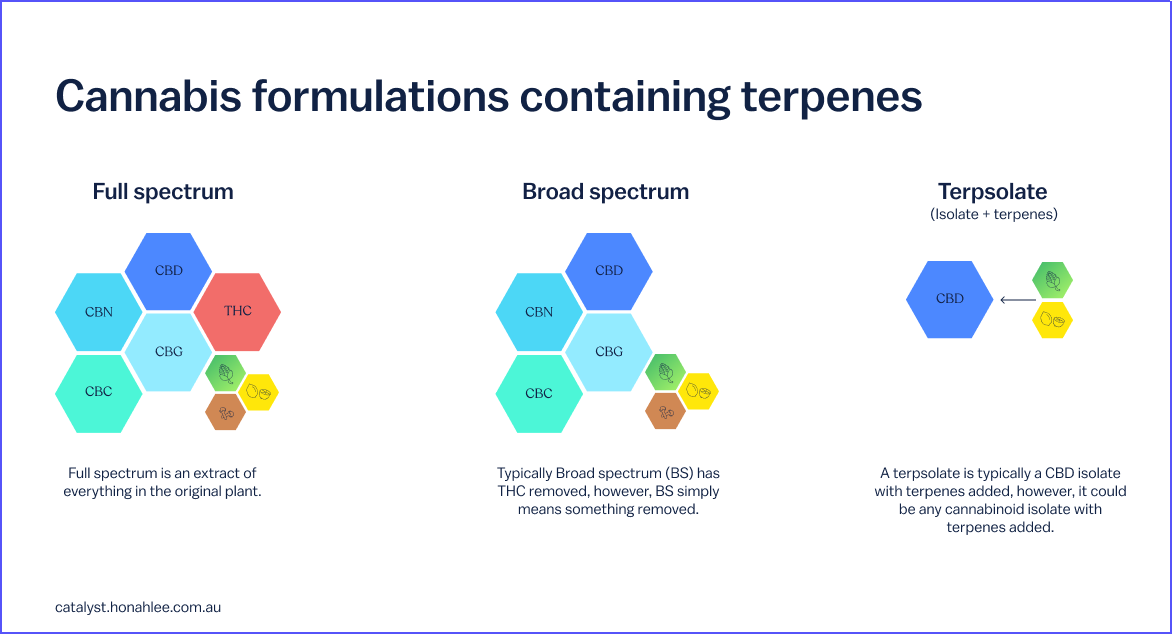What are terpenes? Understanding terpenes and medicinal cannabis
When most people think about medicinal cannabis, they think of THC and CBD. In Australia, THC and CBD are considered the only two Active Pharmaceutical Ingredients (API) by the Therapeutic Goods Administration (TGA). While this may be the TGA perspective, many health practitioners are beginning to recognise terpenes as a vital part of cannabinoid therapy.
What makes terpenes so important? When a patient needs something uplifting so that they can manage their pain throughout the day and not feel sleepy, we often hear “Sativa.” While most people think that understanding, if the medicine is a Sativa and Indica, will determine how the treatment will feel (the mood of the medicine), it’s the terpenes that determine the outcome.
Once you understand terpenes more, you may start to question whether a product that isn’t an isolate is actually the same from batch to batch if the terpene profile isn’t similar (or measured).
In this article, you’ll learn enough about terpenes to start thinking about terpene profiles when choosing a cannabis product for a patient. Here’s what our two experts, Dr Jim and Nurse Cam, talk about in the accompanying video:
- 00:19 | What are terpenes?
- 02:58 | Where are terpenes found?
- 04:38 | Do all cannabis products have terpenes?
- Includes types of products that do contain terpenes
- 08:42 | How do terpenes affect the body?
- 09:39 | Can terpenes make you high?
- 10:27 | Are there any side effects of terpenes?
- 12:11 | Understanding terpene interactions and cannabis terpene profiles (video only)
- 16:23 | Conclusion
Then, in part two of this terpene series you can learn about common terpenes, doses and benefits. You can also check out our terpene chart which as terpene vaporisation temperatures.
What are terpenes?
Terpenes are aromatic hydrocarbon molecules responsible for the unique scents of plants. Terpenes are found in relatively large quantities in cannabis. They are expressed in the leaves, flowers, fruit and sap of plants. Terpenes’ job is to provide protection from predators, environmental fluctuations and help to attract pollinators.
While they have a few different roles for the plant, terpenes are responsible for the aroma and scent of plants, including cannabis.
The smell of rose is not just rose. It’s a combination of citronellol, geraniol, linalool, farnesol, a-pinene, b-pinene, limonene, camphene, b-caryophyllene and other terpenes. The same goes for cannabis varieties.
Cam Rosin, Nurse
In addition to creating the aroma of plants, terpenes are also considered to be the ‘effect-drivers’ of cannabis. So, rather than talking about whether a product is an Indica or Sativa, we should be talking about the plant’s terpene profile.
Where are terpenes found?
Terpenes can be found in abundance in nature. Around 20,000 terpenes have been identified, with about 200 expressed in the cannabis plant. All plants have terpenes, and surprisingly even a few animals produce terpenes. The same terpenes in cannabis are found in plants and spices such as rosemary, lavender, mangoes, sage, pine trees, eucalyptus, and many more.
Cannabis terpenes are not different from other terpenes. If you’ve ever experienced a drop of lavender on your pillow, a warm florist on a sunny afternoon, a deep breath in a pine forest, or lemon-scented cleaning products, you’ve experienced the same type of terpenes you’ll find in cannabis.
Cam Rosin, Nurse
In cannabis, terpene concentrations max out at about 2-4% of total weight. While this can be higher in certain chemovars, terpenes are volatile and subject to degradation during curing processes or heated extraction techniques.
Do all cannabis products have terpenes?

Unfortunately, not all cannabis products have terpenes. And, for the products that do contain terpenes, not all product suppliers measure terpenes from batch to batch.
To help you understand which products have terpenes, you need to understand the different types of products that exist. There are three main types of cannabis formulations:
- Full-spectrum
- Broad-spectrum
- Isolates
There are also terpsolates which are increasingly popular overseas and have recently landed in Australia.
Full Spectrum Products – Contain Terpenes
Full-spectrum products are extracts that contain most of what was in the original plant, including terpenes. The difference between full-spectrum and the full plant is that the fats, waxes, and other fibrous materials are removed in full spectrum.
Unfortunately, many extraction methods drastically reduce the original plant’s terpene content, which is why having Certificates of Analysis with terpenes included is so important.
It’s also important to note that many companies add terpene blends to their products. For the product to be full-spectrum, the product must have the original terpenes from the plant.
Broad Spectrum Products – Contain Terpenes
Broad-spectrum cannabis products are the same as full spectrum, with something removed. The chemical removed is usually THC. However, broad-spectrum means something was removed.
Isolates – Do Not Contain Terpenes
Isolate products contain only one compound from the original plant. For example, there are CBD and THC isolates. These products do not contain any terpenes or other cannabinoids. These products are often thought to have less efficacy than a broad or full spectrum product.
Terpsolates – Contain Terpenes (but not the original terpenes)
Terpsolates are the same as isolates with a terpene or terpene blend added to the isolate. The terpenes that have been added back in are not the terpenes from the original plant. This is a relatively new idea; however, there are products available in Australia that are in this category.
How do terpenes affect the body?
Like other chemicals in the cannabis plant, Terpenes work on different receptors in the body. Terpenes have weak to moderate actions at the following receptors (Ref 1, Ref 2):
- GABA receptors
- Adenosine receptors
- 5-HT1a receptors
- PPAR-y receptors
- CB2 receptors
Despite having low concentrations in cannabis, they are highly bioactive, especially when inhaled. And, many terpenes are considered to be ‘promiscuous’ molecules with mixed mechanisms of action. Terpenes have been shown to improve THC pharmacokinetics by increasing vasodilation of alveolar capillaries by permitting more absorption of THC by the lungs and increasing blood-brain barrier permeability.
For example, limonene, a terpene also found in citrus, appears to have agonistic effects at 5HT1A, adenosine and dopamine receptors (Ref 1, Ref 2, Ref 3). This may be why cannabis consumers report that chemovars with strong citrus aromas are the best for improving mood.
Cam Rosin, Nurse
A theory called “The Entourage Effect” states that all chemicals in the plant work better together than in isolation. While there is limited research to prove this theory, terpenes are thought to contribute to the entourage effect significantly.
Can terpenes make you high?
No. Terpenes alone can not produce psychoactive effects or make you high.
Are there any side effects of terpenes?
Like any other chemical, synthesised or natural, there may be side effects. However, while possible, terpene side effects are uncommon. Side effects may occur in individuals who are hypersensitive to terpenes.
Some terpenes can cause irritation, allergic reactions, nausea, headaches and/or acute toxic effects at very high doses. However, these doses are substantially higher than is possible to consume when using cannabis products.
Patients will have a unique set of terpenes that work best for them. Similar to cannabis formulations, it’s rare to find a single product that works best for everyone. Patients will often need to test different terpenes and combinations of terpenes to find what’s best for them and what doesn’t work.
Recap & Conclusion
Terpenes are the essential oils of plants and are responsible for the scent of plants and cannabis chemovars. There is limited clinical evidence for terpenes; however, terpenes are all around us and have been used for thousands of years in herbal medicines.
When thinking about products for patients, it’s important to remember that there is a growing body of research for the entourage effect and that terpenes are likely to enhance the impact of cannabinoids. Terpenes are found in full-spectrum, broad-spectrum and terpsolate products and are generally well tolerated.
An increasing number of product suppliers measure terpene content from batch to batch in both oil and flower products. Therefore, it’s always good to review CoAs to know which suppliers are transparent about what chemicals are in their products and how similar they are from batch to batch.
If you’re a health practitioner and want to see which products have terpenes and have the ability to review CoAs and compare products side by side, you can start your free 14 day trial of the Cannabis Medicines Database.
